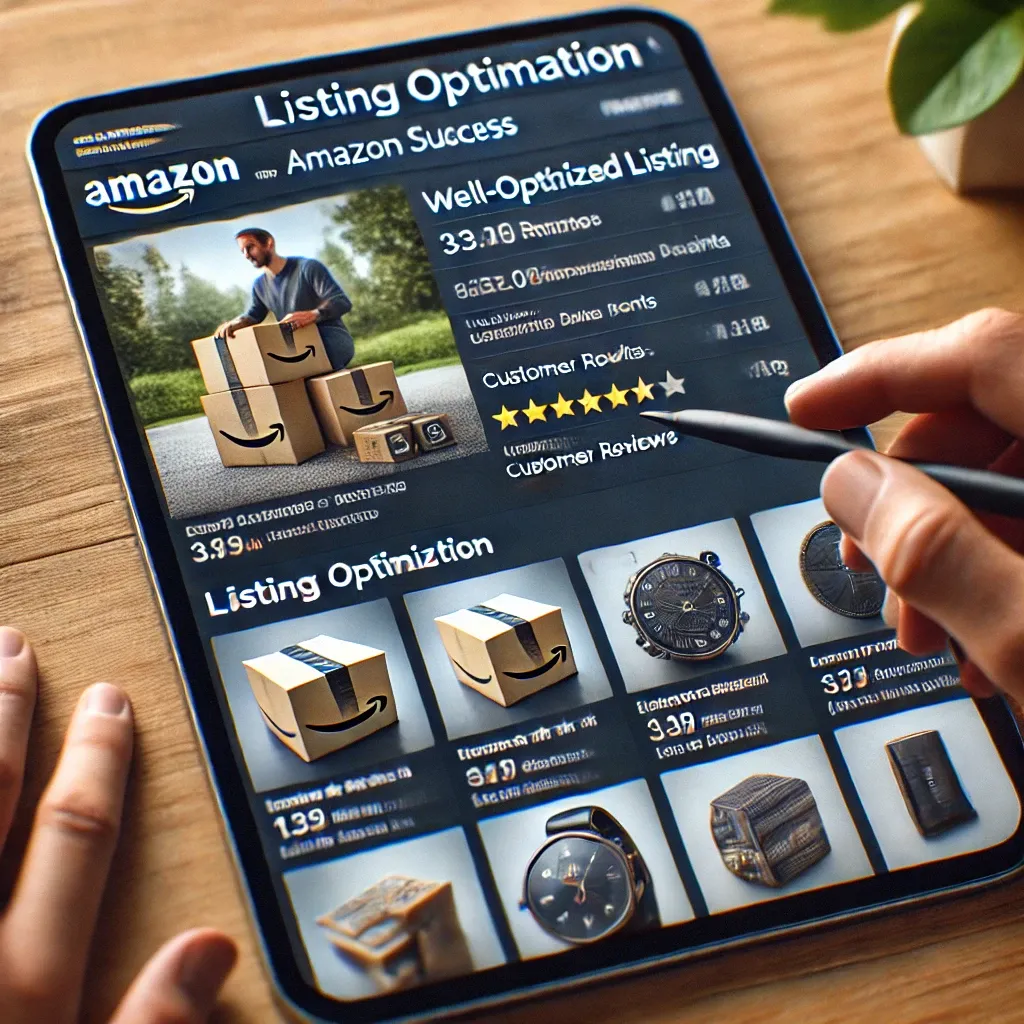How to Crush It on Amazon in 2024: Real Tips for Real Success

If you’ve been thinking about diving into the Amazon selling game, 2024 might just be your year. With the right approach, this massive marketplace can offer incredible opportunities for sellers, whether you’re brand new or a seasoned pro. But let’s be real—succeeding on Amazon isn’t as simple as listing a product and waiting for the sales to roll in. It takes strategy, savvy, and a willingness to adapt. Let’s break down some key tips and strategies to help you crush it on Amazon this year.
1. Amazon Isn’t Just for Big Brands
One of the biggest misconceptions about Amazon is that it’s dominated by big brands. While it’s true that major companies have a presence, the real power behind Amazon comes from third-party sellers—people like you and me. In fact, over 60% of the products sold on Amazon come from third-party sellers. Last year, over 10,000 of these sellers hit the $1 million sales mark for the first time. So, yes, there’s plenty of room to grow, but you’ve got to play it smart.
2. Understand the Different Selling Models
Amazon offers a variety of ways to sell, and choosing the right model for your business can make all the difference. Here’s a quick rundown of the most popular options:
- Merch by Amazon: This is perfect for creatives who want to design products like t-shirts or mugs without worrying about inventory. You create the design, Amazon handles the printing and shipping, and you earn royalties. It’s low-risk and doesn’t require upfront investment.
- Retail & Online Arbitrage: If you’re good at finding deals, this might be for you. The idea is to buy products at a discount—either from physical stores (retail arbitrage) or online (online arbitrage)—and then resell them on Amazon at a higher price. This model can be particularly lucrative during peak seasons.
- Drop Shipping: This model involves listing products on Amazon that you don’t physically stock. When a customer places an order, you purchase the product from a supplier who ships it directly to the customer. It’s a great way to sell without the hassle of managing inventory.
- Private Label: For those who want to build a brand, private labeling is the way to go. This involves manufacturing your own products and selling them under your brand name. It requires more investment upfront, but the potential for profit and brand loyalty is significant.
3. The Secret Sauce: Capitalizing on Demand
Here’s the truth: to succeed on Amazon, you need to sell products that people are actively searching for. Amazon isn’t the place to launch a never-before-seen product that nobody’s searching for—it’s about finding a product with existing demand.
So, how do you find that perfect product? Start by doing your homework. Tools like Helium 10 can help you analyze search trends, see what’s hot, and identify niches with strong demand but limited competition. The goal is to find that sweet spot where you can step in and offer something valuable.
4. The Power of Keywords
On Amazon, keywords are everything. They’re how customers find your product, so getting them right is crucial. Think of keywords as the language your potential buyers speak—if you’re not speaking their language, they’ll never find you.
Use tools like Helium 10 to identify the exact keywords people are using to search for products like yours. Then, make sure those keywords are sprinkled throughout your product titles, descriptions, and bullet points. But don’t just stuff your listing with keywords—make sure it reads naturally and provides valuable information.
5. Listing Optimization is a Must
Your product listing is your storefront on Amazon. If it’s not appealing, customers will move on without a second thought. High-quality images, engaging product descriptions, and clear, concise bullet points are non-negotiable.
Think of your listing as your pitch—it needs to grab attention and convince the shopper to click that “Buy Now” button. And remember, your listing isn’t something you set and forget. Regularly review it to see what’s working and what’s not. Adjust your images, refine your descriptions, and make sure your keywords are up to date.
6. Inventory Management: The Unsung Hero
Managing your inventory effectively is critical to your success on Amazon. If you run out of stock, you lose sales and potentially your ranking. On the flip side, if you overstock, you’re tying up capital and paying unnecessary storage fees.
To strike the right balance, use inventory management tools that help forecast demand based on past sales, seasonality, and current trends. Regularly review your stock levels and be proactive in adjusting your orders. It’s a delicate balance, but getting it right can significantly impact your profitability.
7. Reviews: Love Them or Hate Them, They Matter
Reviews are the lifeblood of your Amazon business. Positive reviews can boost your product’s visibility and credibility, while negative reviews can drag you down. But here’s the thing: reviews aren’t just about star ratings—they’re also about customer experience.
Make sure you’re delivering on your promises. If something goes wrong, address it quickly and professionally. A prompt, courteous response can sometimes turn a negative review into a positive one. Encourage satisfied customers to leave reviews, and don’t shy away from asking for feedback.
8. Advertising: Pay to Play
Amazon’s advertising platform, particularly pay-per-click (PPC) ads, is a powerful tool for getting your products in front of more shoppers. Bidding on the right keywords can place your product at the top of search results, driving more visibility and sales.
But be smart about it. Set a budget, monitor your ad performance, and adjust your campaigns based on what’s working. Advertising can be a great way to kickstart sales, especially when launching a new product, but it’s important to manage your spend effectively.
9. Keep an Eye on the Competition
Amazon is a competitive marketplace, and to stay ahead, you need to keep an eye on what your competitors are doing. Regularly check their listings, pricing, and customer reviews. Look for gaps or opportunities where you can differentiate yourself.
This doesn’t mean copying what they’re doing—it means learning from their successes and mistakes. Use this information to refine your own strategy and stay competitive.
10. It’s Not Set It and Forget It
Selling on Amazon isn’t a one-and-done deal. It’s a constant process of tweaking, optimizing, and adjusting your approach. From monitoring keyword ranks to managing inventory and staying compliant with Amazon’s ever-evolving policies, there’s always something to stay on top of.
The sellers who thrive on Amazon are those who remain flexible and responsive. Keep learning, stay proactive, and be ready to adapt to new challenges.
Final Thoughts
Selling on Amazon in 2024 is an exciting opportunity, but it’s not without its challenges. By focusing on the right strategies—capitalizing on demand, optimizing your listings, managing your inventory smartly, and staying responsive to customer feedback—you can carve out your own piece of the pie.
Remember, Amazon is a dynamic platform, and success comes to those who are willing to put in the work and stay ahead of the game. So, are you ready to crush it on Amazon this year?
Q&A Section
Q: What’s the biggest mistake new sellers make on Amazon?
A: One of the biggest mistakes new sellers make is jumping into highly competitive product categories without proper research. Selling generic products like plain t-shirts or phone cases might seem easy, but these categories are often saturated. Instead, focus on finding niche products with demand but less competition. Using tools like Helium 10 can help you identify these opportunities.
Q: How do I choose the right selling model on Amazon?
A: The right selling model depends on your goals, budget, and experience level. If you’re creative and want to start with minimal investment, Merch by Amazon is a great option. If you’re good at finding deals, consider retail or online arbitrage. Drop shipping is ideal if you want to avoid handling inventory. For long-term brand building, private labeling is the way to go, though it requires more upfront investment.
Q: How important are product reviews on Amazon?
A: Reviews are crucial on Amazon. Positive reviews build trust and can significantly boost your product’s ranking and sales. On the flip side, negative reviews can hurt your visibility and deter potential customers. It’s important to provide excellent customer service, address issues quickly, and encourage satisfied customers to leave positive reviews.
Q: How can I effectively manage my inventory on Amazon?
A: Effective inventory management is key to avoiding stockouts and overstocking. Use inventory management tools to forecast demand based on past sales data and current trends. Regularly monitor your stock levels and adjust your orders accordingly. Keeping your inventory balanced ensures you can meet customer demand without tying up too much capital in excess stock.
Q: Is advertising necessary for success on Amazon?
A: While it’s possible to succeed on Amazon without advertising, running pay-per-click (PPC) campaigns can greatly enhance your visibility and sales, especially when launching a new product. Advertising helps you reach more customers and can give you a competitive edge. However, it’s important to monitor your ad spend and optimize your campaigns to ensure you’re getting a good return on investment.
Q: How do I stay competitive on Amazon?
A: Staying competitive on Amazon involves regularly monitoring your competitors, optimizing your listings, and staying informed about changes in Amazon’s policies and marketplace trends. It’s also important to continuously gather and act on customer feedback. Staying agile and responsive will help you adapt to new challenges and maintain a strong presence on the platform.




